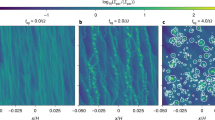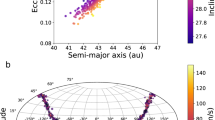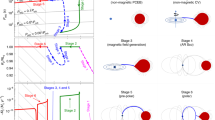Abstract
Asteroids with satellites are observed throughout the Solar System, from subkilometre near-Earth asteroid pairs to systems of large and distant bodies in the Kuiper belt. The smallest and closest systems are found among the near-Earth and small inner main-belt asteroids, which typically have rapidly rotating primaries and close secondaries on circular orbits. About 15 per cent of near-Earth and main-belt asteroids with diameters under 10 km have satellites1,2. The mechanism that forms such similar binaries in these two dynamically different populations was hitherto unclear. Here we show that these binaries are created by the slow spinup of a ‘rubble pile’ asteroid by means of the thermal YORP (Yarkovsky–O’Keefe–Radzievskii–Paddack) effect. We find that mass shed from the equator of a critically spinning body accretes into a satellite if the material is collisionally dissipative and the primary maintains a low equatorial elongation. The satellite forms mostly from material originating near the primary’s surface and enters into a close, low-eccentricity orbit. The properties of binaries produced by our model match those currently observed in the small near-Earth and main-belt asteroid populations, including 1999 KW4 (refs 3, 4).
This is a preview of subscription content, access via your institution
Access options
Subscribe to this journal
Receive 51 print issues and online access
$199.00 per year
only $3.90 per issue
Buy this article
- Purchase on Springer Link
- Instant access to full article PDF
Prices may be subject to local taxes which are calculated during checkout



Similar content being viewed by others
References
Pravec, P. et al. Photometric survey of binary near-Earth asteroids. Icarus 181, 63–93 (2006)
Pravec, P. & Harris, A. W. Binary asteroid population. Icarus 190, 250–259 (2007)
Ostro, S. J. et al. Radar imaging of binary near-Earth asteroid (66391) 1999 KW4. Science 314, 1276–1280 (2006)
Scheeres, D. J. et al. Dynamical configuration of binary near-Earth asteroid (66391) 1999 KW4. Science 314, 1280–1283 (2006)
Richardson, D. C. & Walsh, K. J. Binary minor planets. Annu. Rev. Earth Planet. Sci. 34, 47–81 (2006)
Walsh, K. J. & Richardson, D. C. Binary near-Earth asteroid formation: Rubble pile model of tidal disruptions. Icarus 180, 201–216 (2006)
Walsh, K. J. & Richardson, D. C. A steady-state model of NEA binaries formed by tidal disruption of gravitational aggregates. Icarus 193, 553–566 (2008)
Michel, P. et al. Collisions and gravitational reaccumulation: forming asteroid families and satellites. Science 294, 1696–1700 (2001)
Durda, D. D. et al. The formation of asteroid satellites in catastrophic impacts: Results from numerical simulations. Icarus 167, 382–396 (2004)
Rubincam, D. P. Radiative spin-up and spin-down of small asteroids. Icarus 148, 2–11 (2000)
Paddack, S. J. & Rhee, J. W. Rotational bursting of interplanetary dust particles. Geophys. Res. Lett. 2, 365–367 (1975)
Lowry, S. C. et al. Direct detection of the asteroidal YORP effect. Science 316, 272–274 (2007)
Taylor, P. A. et al. Spin rate of asteroid (54509) 2000 PH5 increasing due to the YORP effect. Science 316, 274–277 (2007)
Kaasalainen, M., Dˇurech, J., Warner, B. D., Kugly, Y. N. & Gaftonyuk, N. N. Acceleration of the rotation of asteroid 1862 Apollo by radiation torques. Nature 446, 420–422 (2007)
C´uk, M. Formation and destruction of small binary asteroids. Astrophys. J. 659, 57–60 (2007)
Pravec, P. & Harris, A. W. Fast and slow rotation of asteroids. Icarus 148, 12–20 (2000)
Richardson, D. C., Leinhardt, Z. M., Melosh, H. J., Bottke, W. F. & Asphaug, E. in Asteroids III (eds Bottke, W. F. Jr, Cellino, A., Paolicchi, P. & Binzel, R. P.) 501–515 (Univ. of Arizona Press, Tucson, AZ, 2002)
Richardson, D. C., Elankumaran, R. E. & Sanderson, R. E. Numerical experiments with rubble piles: equilibrium shapes and spins. Icarus 173, 349–361 (2005)
Fujiwara, A. et al. The rubble-pile asteroid Itokawa as observed by Hayabusa. Science 312, 1330–1334 (2006)
Supulver, K. D., Bridges, F. G. & Lin, D. N. C. The coefficient of restitution of ice particles in glancing collisions: Experimental results for unfrosted surfaces. Icarus 113, 188–199 (1995)
Fujii, Y. & Nakamura, A. M. Compaction and fragmentation of porous targets at low velocity collisions. Lunar Planet. Sci. Conf. XXXVIII abstract 1525 (2007)
Acknowledgements
We thank W. F. Bottke and A. Harris for their constructive reviews. K.J.W. and D.C.R. acknowledge support from the National Science Foundation under grants AST0307549 and AST0708110. K.J.W. and P.M. also had the support of the European Space Agency’s Advanced Concepts Team on the basis of the Ariadna study 07/4111 ‘Asteroid Centrifugal Fragmentation’, and of the French Programme National de Planétologie. K.W. is also supported by the Henri Poincaré fellowship at the Observatoire de la Côte d’Azur, Nice, France. We acknowledge the use of the Mésocentre de Calcul-SIGAMM hosted at the Observatoire de la Côte d’Azur, Nice, France. Some simulations were performed at the University of Maryland with the Department of Astronomy borg cluster and the Office of Information Technology High Performance Computing Cluster. Raytracing for Figs 1 and 3 was performed with the Persistence of Vision Raytracer.
Author information
Authors and Affiliations
Corresponding author
Rights and permissions
About this article
Cite this article
Walsh, K., Richardson, D. & Michel, P. Rotational breakup as the origin of small binary asteroids. Nature 454, 188–191 (2008). https://doi.org/10.1038/nature07078
Received:
Accepted:
Issue Date:
DOI: https://doi.org/10.1038/nature07078
This article is cited by
-
Physical properties of asteroid Dimorphos as derived from the DART impact
Nature Astronomy (2024)
-
DART’s asteroid bullseye
Nature Geoscience (2023)
-
Particle size distributions inside and around the artificial crater produced by the Hayabusa2 impact experiment on Ryugu
Earth, Planets and Space (2022)
-
Inferring interiors and structural history of top-shaped asteroids from external properties of asteroid (101955) Bennu
Nature Communications (2022)
-
Doublet craters originated by low speed impact experiments in granular matter
Granular Matter (2022)
Comments
By submitting a comment you agree to abide by our Terms and Community Guidelines. If you find something abusive or that does not comply with our terms or guidelines please flag it as inappropriate.



